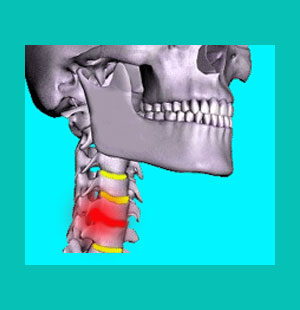
A cervical bulging disc describes an intervertebral abnormality in which the spinal spacer loses its typical symmetry and demonstrates a protrusion of intact annular tissue that may also be called a herniation, depending on its severity. Bulging discs are found throughout the cervical spinal region in great numbers, but are most prevalent in the middle to lower levels of the neck.
Bulging discs in the neck are not inherently painful or problematic. In fact, most do not cause any symptoms whatsoever. However, intervertebral bulging is not completely innocent either, since bulges may worsen or create symptoms through several possible mechanisms.
This treatise examines the occurrence of cervical bulging discs and details the factors that contribute to intervertebral bulging and the consequences of spinal disc herniation in the cervical levels of the backbone.
Cervical Bulging Disc Definitions
As mentioned in several other topical discussions throughout this website, bulging disc is a diagnostic term that is basically synonymous with intervertebral herniation. Some doctors use the terms interchangeably, while others might use the terms to describe slightly different variations of a condition. Disc bulge is often considered less severe than disc herniation, although this is really a matter of semantics for some caregivers more than any official definition of either diagnostic term.
Disc bulges generally always describe herniations wherein the outer disc wall remains intact. This means there is no known annular tear so the nucleus pulposus remains enclosed by the annulus fibrosus in its entirety.
Of course adding the word cervical to the term disc bulge locates the intervertebral abnormality in the neck region. There are 6 discs in the cervical spine, including the transitional disc that is placed between the C7 and T1 vertebrae at the cervicothoracic juncture. Most bulging discs in the neck occur at C4/C5, C5/C6, C6/C7 or at the cervicothoracic disc at C7/T1.
Cervical Disc Bulge Causes and Consequences
Bulging discs are now considered to be a normal part of the lifecycle for many intervertebral structures in the backbone. Discs can bulge due to injury, degeneration or idiopathic factors, but most people will demonstrate one or more bulging discs somewhere in the spine.
Age, trauma, use, genetic and idiopathic factors will all contribute to bulging discs and many of these factors act upon the structures of the cervical spine. Remember that the neck must move constantly and work diligently to support the head throughout life. All this wear and tear will naturally affect the cervical discs, causing them to bulge, herniate and rupture more frequently than any other spinal disc locations, except the middle to low lumbar region.
Cervical bulging discs themselves are not painful, since the disc feels no pain. Therefore, the majority of bulges in the c-spine do not cause pain or related neurological symptoms. However, some bulges can be pathological immediately, or with the passage of time, potentially causing a range of problematic expressions for the victim:
Bulging discs can cause focal pressure on spinal nerve roots, causing lateral recess stenosis or neuroforaminal stenosis that leads to a pinched nerve condition in the neck.
Bulging discs can exert focal pressure on the spinal cord in the neck, potentially causing central stenosis that can have wide ranging effects and severe neurological consequences.
Unless some variety of neurological tissue is compressed, the cervical disc bulge should remain asymptomatic, regardless of its size or location.
Cervical Bulging Disc Conclusions
Disc bulges and herniations are confusing topics for most diagnosed patients, especially when their diagnostician uses both terms to mean slightly different things. This is one of the main reasons we have been campaigning for standardization of diagnostic dorsalgia terminology for decades, but so far, few physicians have complied with the latest guidelines set forth by their own governing medical associations.
Since we can not cover diagnostic terminology that may be used by every doctor, we always advise patients to speak to their physicians and allow each doctor to describe what differences, if any, they recognize between herniated and bulging discs. If the doctor does differentiate, but can not clearly detail the reasons and differences between the two conditions, this is a warning sign that the physician might not be your best choice of care provider.
If they do differentiate, it is also a great idea to ask them why, since most doctors will use the terms virtually interchangeably. The most common answer we receive from physicians is that bulges seem less severe than herniations, but both describe virtually identical changes to a greater or lesser degree.
We hope that this essay helps diagnosed patients to better understand intervertebral bulging in the neck. If you still have questions, this entire web resource is 100% focused on disc problems in the human spine. Please browse our site map to find the answers to any inquiry you may have or utilize our easy site search feature.





